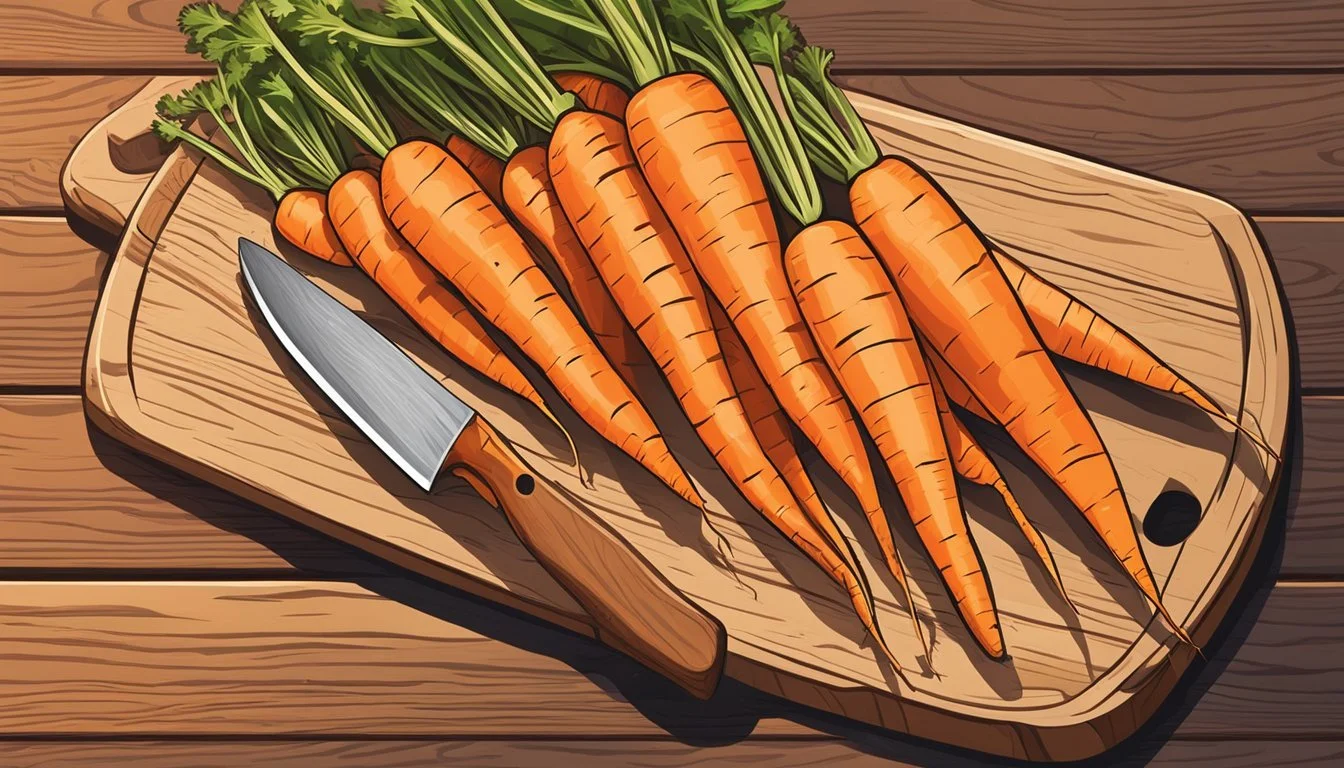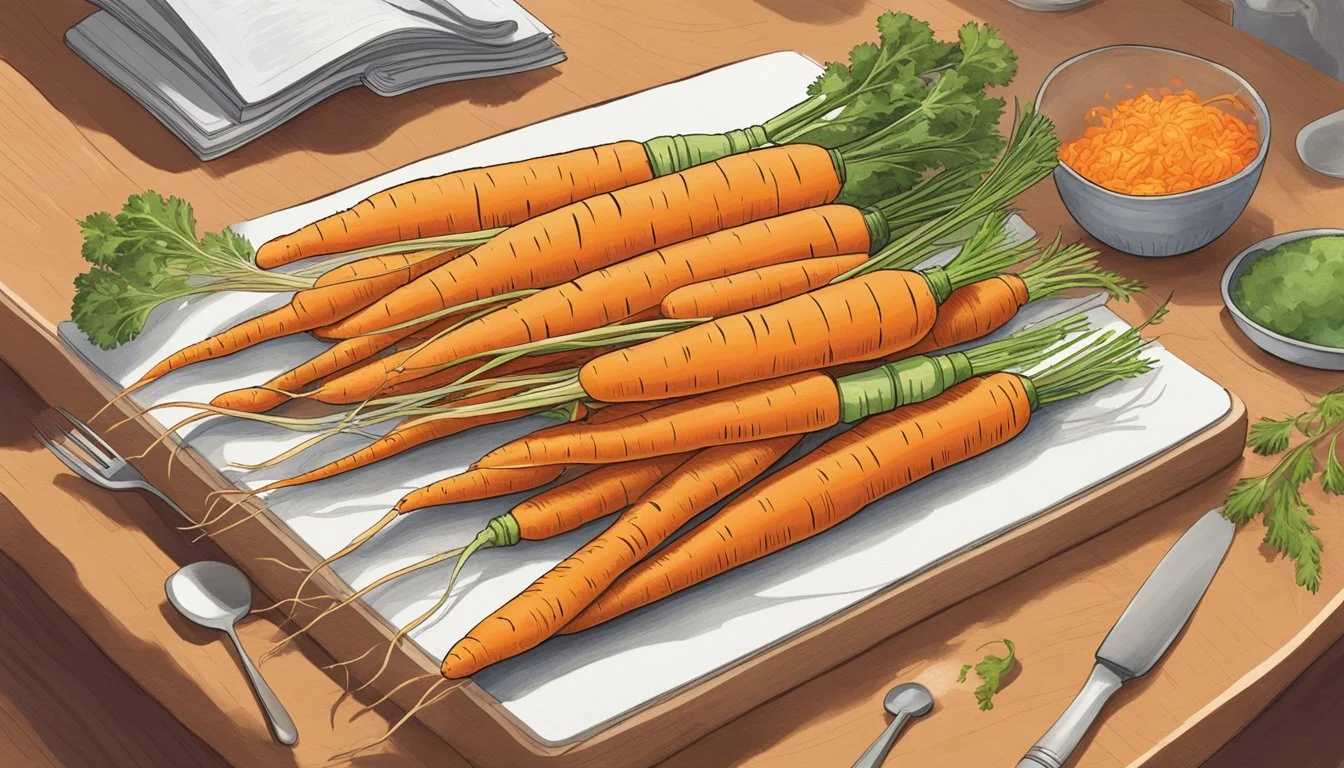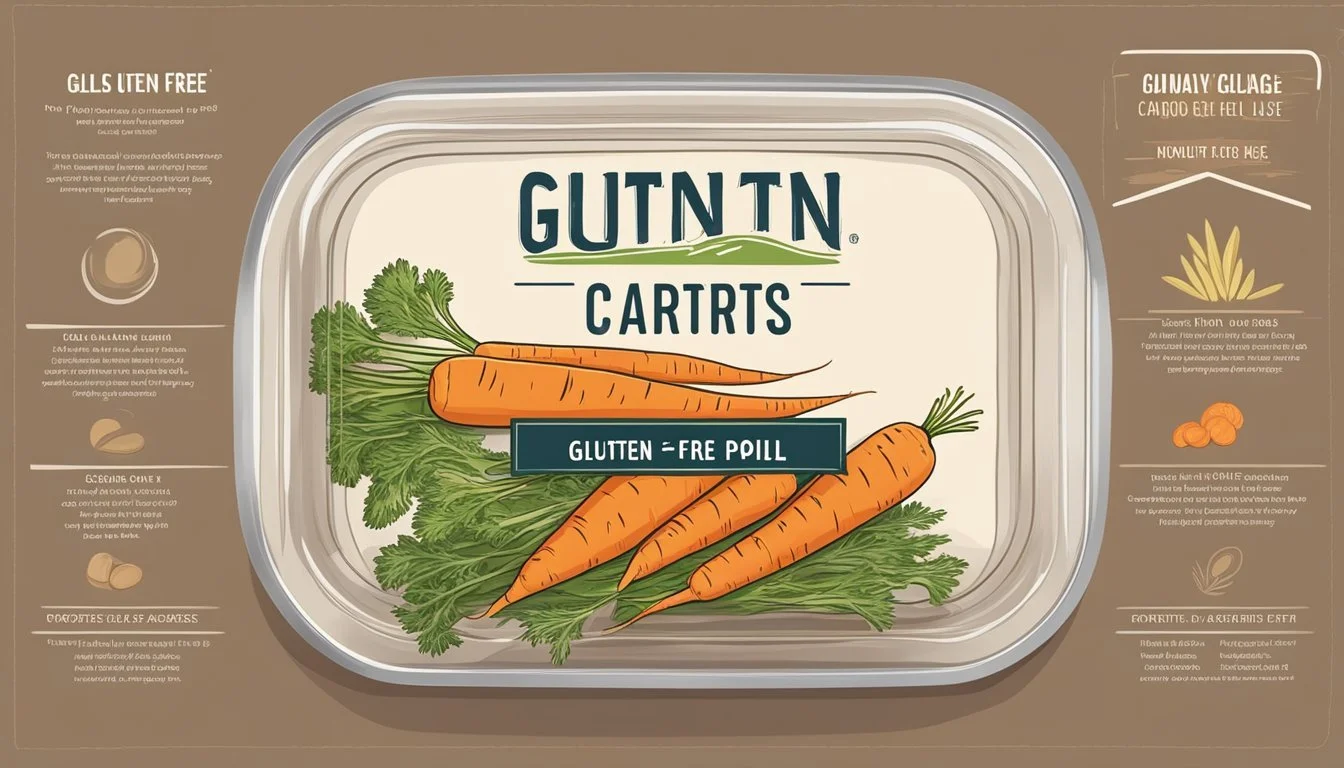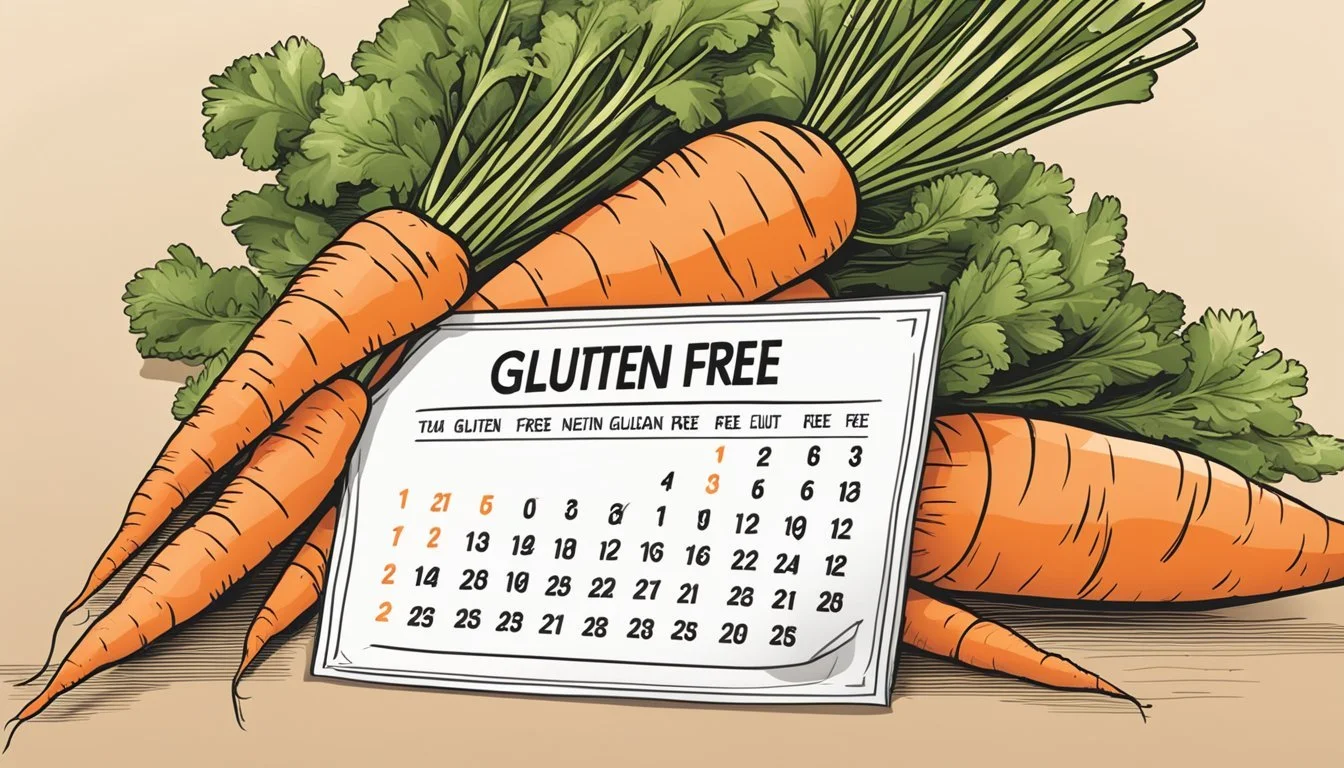How Long Do Gluten-Free Carrots Last?
Shelf Life Tips and Storage Advice
When it comes to gluten-free carrots, understanding their shelf life can significantly impact meal planning and reduce food waste. Stored properly in the fridge, whole unpeeled carrots can last up to 30 days, depending on storage methods. For carrots refrigerated in plastic bags, they usually keep well for around two weeks.
To maximize the freshness of gluten-free carrots, consider storing them in a container full of fresh water and changing the water every 4-5 days. This method helps maintain their crispiness for up to four weeks. For those who prefer a more straightforward approach, simply placing the carrots in the fridge without additional steps can still ensure they stay fresh for at least a couple of weeks.
Carrots that have passed their expiration date can still be eatable if stored properly. Unpeeled carrots can last between three to four weeks past their expiration date, while peeled or baby carrots can last up to two weeks beyond the date. This flexibility makes gluten-free carrots a versatile and durable option for any kitchen.
Understanding Gluten-Free Foods
Gluten-free foods are essential for individuals with celiac disease or gluten intolerance. Gluten is a protein found in wheat, barley, and rye. Consuming products containing gluten can lead to adverse health effects for those affected.
For someone with celiac disease, even small amounts of gluten can cause damage to the small intestine. Therefore, it's crucial to avoid all sources of gluten.
Foods like wheat, barley, oats (unless certified gluten-free), and malt should be avoided. Instead, they should opt for naturally gluten-free foods such as fruits, vegetables, and gluten-free grains like rice and quinoa.
Carrots, being a vegetable, are naturally gluten-free. They can be consumed safely by individuals following a gluten-free diet. These vegetables are versatile and can be included in numerous dishes without risking gluten exposure.
Packaged gluten-free foods often have a shorter shelf life compared to their gluten-containing counterparts due to the use of refined starches. These starches can cause gluten-free products to go stale quickly. Proper storage is key to maintaining their freshness.
Label reading is critical. Gluten can sometimes be hidden in sauces, dressings, and processed foods. Checking for certification labels or specific mentions of being gluten-free is important.
By focusing on whole, unprocessed foods and double-checking labels, those on a gluten-free diet can manage their health effectively and enjoy a variety of safe and delicious foods.
The Basics of Carrots
Carrots are root vegetables known for their crisp texture and sweet flavor. They come in a variety of colors, such as orange, purple, red, yellow, and white.
Rich in nutrients, carrots are an excellent source of fiber, vitamins A, C, K, and B6, and important minerals like potassium.
Grown in both cool and warm climates, carrots are versatile and can be consumed raw or cooked. They are often used in salads, soups, and side dishes.
Nutritional Highlights
Vitamins: High in Vitamin A (important for vision), Vitamin C, and Vitamin K.
Fiber: Promotes digestive health.
Minerals: Contains potassium, which supports heart health.
Storage Tips
Carrots should be stored in a cool, dark place or in the refrigerator to maintain their freshness. When stored in the fridge, they can last for up to 2-4 weeks.
To keep carrots fresh and crunchy, one effective method is to store them in a container with fresh water and change the water every 4-5 days.
Fun Facts
Carrots were initially grown for their aromatic leaves and seeds rather than their roots.
They are among the top ten most economically important vegetable crops in the world.
This basic understanding of carrots highlights their nutritional benefits and storage recommendations, making them a valuable addition to any diet.
Purchasing and Preparing Carrots
When buying carrots, freshness is key. Look for bright orange carrots without any dark spots or blemishes. Whether purchasing whole carrots or baby carrots, they should feel firm. Avoid any that feel limp or rubbery.
For whole carrots, peeling is often necessary. However, this can depend on the recipe. Some recipes, like glazed carrots, may not require peeling. When peeled, carrots must be stored properly to maintain freshness for up to two weeks in the refrigerator.
When preparing carrots, the first step is to wash and trim the ends. Baby carrots might only need a rinse as they are usually pre-peeled and trimmed. For whole carrots, peeling can be done with a vegetable peeler.
Carrots can be sliced, diced, or julienned depending on the recipe's needs. Blanching carrots helps preserve their color and nutrients. For this, boil the prepared carrots for around 4 minutes, then place them in an ice bath.
Creating a glazed carrot dish involves a few basic ingredients like butter, maple syrup, salt, and pepper. Prep time for such a dish is roughly 15 minutes, with cooking requiring an additional 8-10 minutes.
When dealing with baby carrots or peeled carrots, ensure they are stored in a plastic bag or airtight container to keep them crisp.
A quick purchasing tip: If planning to use carrots within a few days, room temperature storage can suffice. For longer storage, up to 30 days, refrigerating them in a plastic bag is recommended.
Storage Techniques for Carrots
Carrots can stay fresh and crisp for different periods depending on the storage method used. Various techniques extend their shelf life, maintaining their quality and taste. Here are some effective storage methods:
Refrigeration:
Plastic Bag: Place whole, unpeeled carrots in a plastic bag. Stored in the vegetable drawer, they can last for about three to four weeks.
Airtight Container: For cut carrots, store them in an airtight container with fresh water. Change the water every 4-5 days to keep them crisp for up to four weeks.
Blanching: Blanch sliced or diced carrots in boiling water for four minutes, then cool them in an ice bath.
Storage: Once cooled, dry the carrots and store them in an airtight container or a plastic bag, then freeze. This method preserves carrots for several months.
Dehydration:
Preparation: Wash, peel, and cut the carrots into thin slices or dice them.
Dehydration: Use a food dehydrator or oven at low heat. Store the dehydrated carrots in an airtight container. They can last for up to a year.
Non-Refrigerated Storage:
Root Cellar: Place carrots in boxes filled with damp sand or sawdust. Maintain a temperature between 32°F and 40°F with good humidity levels to prevent drying out. This method allows storage for several months.
These techniques help ensure that gluten-free carrots remain fresh, nutritious, and ready to use in various dishes.
Optimal Conditions for Carrot Longevity
To keep gluten-free carrots fresh for the longest time, it's crucial to store them under optimal conditions.
Refrigeration:
Carrots thrive in cooler temperatures. The ideal range for storing them in the refrigerator is between 32-41°F (0-5°C). When stored correctly in the fridge, carrots can last anywhere from 14 to 30 days.
Storage Method:
Using a plastic bag to store carrots can help maintain moisture levels, extending their shelf life to about two weeks. Keep them in the crisper drawer for the best results.
Ethylene Exposure:
Carrots are sensitive to ethylene gas, which can speed up their ripening and spoilage. Keep them away from fruits like apples and bananas that emit high amounts of ethylene.
Water and Moisture:
Avoid washing carrots before storage, as excess moisture can lead to rot. Instead, wash them just before use. Wrapping them in a damp paper towel can also help in maintaining the right moisture balance.
Freezing:
For longer preservation, carrots can be frozen. Blanch them first to retain their color and flavor. Once blanched, dry them thoroughly before placing them in airtight freezer bags. Properly frozen carrots can last up to 12 months.
Storage Method Temperature Range Expected Shelf Life Refrigerator 32-41°F (0-5°C) 14 to 30 days Plastic Bag (Fridge) 32-41°F (0-5°C) Around 2 weeks Freezing 0°F (-18°C) Up to 12 months
Maintaining proper storage conditions significantly extends the freshness and flavor of gluten-free carrots. Careful attention to temperature, moisture, and ethylene exposure ensures maximum longevity.
Identifying and Preventing Carrot Spoilage
Knowing how to properly identify and prevent carrot spoilage can help you maximize their shelf life and reduce waste. Below are the key signs to look for when determining freshness and effective methods to prevent spoilage.
Signs of Freshness and Spoilage
Fresh carrots should be firm, smooth, and bright in color.
If the carrots have greens attached, the greens should also look fresh and vibrant. Spoiled carrots may exhibit several unfavorable characteristics:
Soft Carrots: If they are soft or mushy, they have likely gone bad.
Slimy Texture: A slimy feel is a clear indicator of spoilage and the presence of bacteria.
Discoloration: Look for brown, black, or green spots, which could indicate mold or decay.
Bad Smell: A rotten smell usually accompanies spoiled carrots and is a strong sign they should be discarded.
Preventing Carrot Spoilage
To prolong the shelf life of carrots, proper storage techniques are essential.
Follow these tips to help prevent spoilage:
Refrigeration: Store carrots in the fridge, ideally in a plastic bag to maintain moisture and freshness.
Ice Bath: Blanching carrots in an ice bath before storing can help to extend their shelf life.
Separation: Remove greens from the carrots before storing, as the greens can draw moisture out, causing the carrots to spoil faster.
Check Regularly: Regularly inspect carrots for any early signs of spoilage, such as soft spots or discoloration, and remove affected ones promptly to prevent them from affecting others.
Adhering to these strategies can significantly extend the time your gluten-free carrots remain fresh.
Extending Shelf Life through Blanching
Blanching is an effective method to extend the shelf life of gluten-free carrots before freezing. It involves a short cooking time which helps preserve the flavor, color, and nutrients.
Bring a pot of water to a boil.
Cut carrots into uniform pieces.
Place carrots in boiling water for 2-3 minutes.
Quickly transfer carrots to an ice water bath to stop the cooking process.
After blanching, carrots should be thoroughly dried before freezing. This prevents ice crystals from forming, ensuring better texture retention.
Freezing Blanched Carrots:
Place dried, blanched carrots in freezer bags or airtight containers.
Label with the date for tracking.
Store in the freezer at the coldest setting.
Blanched and frozen gluten-free carrots can last for up to 9-12 months in the freezer.
Benefits of Blanching:
Preserves nutrients and flavor.
Maintains texture and color.
Extends shelf life significantly.
Blanching offers a practical solution for enjoying fresh carrots over a longer period without compromising on quality.
Creative Uses for Carrots in Recipes
Carrots are versatile ingredients that can enhance many dishes. They can be used in savory dishes, sweet treats, and even beverages.
Roasted Carrots: A simple yet flavorful option. Toss carrot slices with olive oil, salt, and pepper. Roast at 425°F until tender and caramelized.
Glazed Carrots: In a skillet, sauté carrots with butter and a touch of maple syrup. Add some garlic, salt, and pepper for a delightful side dish.
Soups and Stews: Carrots bring a natural sweetness to soups and stews. They blend well with other vegetables and can be mashed for a creamy texture.
Salads: Add grated or thinly sliced carrots to salads for extra crunch and color. Pair them with leafy greens, nuts, and a tangy vinaigrette.
Muffins and Cakes: For a sweet twist, incorporate grated carrots into muffin or cake batter. Carrot cakes and carrot muffins are popular choices that are moist and flavorful.
Carrot Fries: Slice carrots into sticks and season with paprika and salt. Bake until crispy for a healthy alternative to traditional fries.
Smoothies: Blend carrots with fruits like oranges, apples, and ginger for a refreshing and nutritious smoothie.
Dip and Hummus: Puree roasted carrots with garlic, lemon, and tahini for a vibrant and delicious carrot hummus.
By incorporating carrots into various recipes, you can enjoy their nutritional benefits and delicious taste in many creative ways.
Special Considerations for Gluten-Free Recipes
When creating gluten-free recipes, certain factors need careful attention.
Gluten-Free Ingredients: Essential to use ingredients that exclude gluten-containing grains like wheat, barley, and rye. Gluten-free oats can be used if they are labeled as such.
Cross-Contamination: Ensure all cooking surfaces and utensils are thoroughly cleaned to avoid cross-contamination. Even trace amounts of gluten can affect individuals with celiac disease.
For vegan or dairy-free versions, consider using plant-based oils, nut milks, or substitutes like butter alternatives.
Storage for Freshness: Fresh vegetables like carrots, when prepared gluten-free, should be stored in air-tight containers and kept in the refrigerator. Typically, they last about 3-5 days.
Nutritional Needs: A balanced gluten-free diet often requires incorporating various grains like quinoa or millet to ensure proper nutritional intake. It's crucial for those following diets such as paleo or dairy-free to find suitable alternatives that meet their dietary restrictions.
Label Reading: Always read product labels to ensure there are no hidden gluten sources. Ingredients like sauces, dressings, and seasonings should be scrutinized.
Cooking Techniques: Certain techniques may help maintain the integrity of gluten-free ingredients. For example, gently simmering vegetables in a gluten-free broth can enhance flavor without compromising dietary needs.
Recipe Adaptations: Many traditional recipes can be adapted for a gluten-free diet. For instance, using almond flour or gluten-free all-purpose flour in baking can yield great results.
Maintaining strict gluten-free practices ensures that those with celiac disease or gluten sensitivity can enjoy delicious and safe meals.
Preparing Carrots as a Side Dish
To make carrots a standout side dish, use simple techniques like roasting and integrating sweet or savory flavors. Choosing the right seasonings and cooking methods can elevate the taste and presentation of this versatile vegetable.
Roasting Carrots in the Oven
Roasting brings out the natural sweetness in carrots. Preheat the oven to 400°F (200°C). Peel and trim the carrots, then cut them into uniform pieces to ensure even cooking.
Spread the carrots on a baking sheet and drizzle with olive oil. Season with salt, black pepper, and a pinch of thyme. Toss to coat evenly.
Roast in the oven for 20-25 minutes until the carrots are tender and caramelized around the edges. Stir once halfway through for even browning.
For a finishing touch, garnish with fresh herbs or a sprinkle of sea salt.
Sweet and Savory Carrot Side Dishes
Creating sweet and savory carrot dishes enhances their natural flavors. For a sweet twist, glaze carrots with honey or maple syrup. Start by melting butter in a pan over medium heat. Add the carrots and cook until tender. Stir in honey, season with a bit of salt and pepper, and let it coat the carrots for a glossy finish.
For a savory option, sauté carrots with garlic and herbs. Heat olive oil in a skillet, add sliced carrots, and cook until they start to soften. Add minced garlic, thyme, and a touch of chili powder for heat. Sauté until everything is well combined and fragrant.
These methods offer delicious variations to complement any meal, making carrots a versatile and flavorful side dish.
Additional Tips and Tricks
Proper selection of carrots and thoughtful use of ingredients can significantly enhance the quality and taste of gluten-free carrot dishes. Below are important considerations for choosing the right carrots for various recipes and enhancing their flavor with complementary ingredients.
Choosing Carrots for Different Dishes
When selecting carrots for different dishes, it's important to consider size and freshness. Small, tender carrots are ideal for quick cooking methods like sautéing or glazing. Larger carrots are perfect for roasting or adding to stews.
For roasting, look for firm, unblemished carrots. Clean and peel them, then cut into uniform pieces to ensure even cooking. Placing them on a baking sheet with parchment paper and drizzling with olive oil helps achieve a crispy texture.
Carrots stored properly can last longer and retain their crispiness. For example, refrigerating in a container filled with fresh water, changed every few days, can keep them fresh for up to a month.
Enhancing Flavor with Complementary Ingredients
Olive oil and seasonings like kosher salt, pepper, and herbs can add depth to roasted carrots. Brushing carrots with a mix of olive oil and minced garlic before roasting can elevate their flavor profile.
For a sweet glaze, use ingredients such as maple syrup or honey. Combine these with a pinch of salt and pepper to balance the sweetness. Cooking glazed carrots on a medium heat ensures a tender, flavorful result while preventing over-caramelization.
Adding a drizzle of high-quality olive oil and sprinkling with fresh herbs like thyme or parsley before serving can enhance both flavor and presentation. This approach not only boosts taste but also ensures the dish remains gluten-free and appealing.
Food Safety and Carrots
Carrots, whether gluten-free or not, need proper storage to maintain their freshness and prevent spoilage. Stored correctly, carrots can stay fresh for weeks.
When storing carrots in a pantry, ensure the space is cool. Carrots stored in a pantry or room temperature can last around 5 days. For longer storage, refrigeration is crucial.
In the fridge, whole unpeeled carrots in a plastic bag can last for approximately 2 weeks. Alternatively, storing carrots in a container or jar filled with fresh water can keep them crispy for up to 4 weeks. Change the water every 4-5 days.
Signs of Spoiled Carrots:
Bad Smell: A rotten smell indicates spoilage.
Texture: Soft, mushy texture or slimy feel means the carrots are no longer safe to eat.
Appearance: Mold or dark spots signal it’s time to discard them.
Food Safety Tips:
Washing: Always wash carrots thoroughly to remove dirt and potential contaminants.
Peeling: Peel carrots if needed, but note that unpeeled carrots generally have a longer shelf life.
Cutting: Dice or slice as needed, but understand that cut carrots might not last as long as whole ones.
Carrots are naturally gluten-free, dairy-free, egg-free, nut-free, and seed-free, making them a safe option for those with allergies or dietary restrictions. Proper handling ensures they maintain their nutritional quality without compromising safety.
Ceilings and Recommendations for Consumption
When it comes to storing gluten-free carrots, the method of storage significantly impacts their shelf life. Carrots kept in a cool pantry will stay fresh for about 5 days. For longer preservation, refrigeration is recommended.
In a refrigerator, carrots stored in a plastic bag can last from 14 to 30 days.
For families, keeping carrots fresh ensures a readily available, healthy snack.
Picky eaters might enjoy them more if they are crisp and well-stored.
To maximize the shelf life, consider the following recommendations:
Storage: Store carrots in a plastic bag with some ventilation.
Temperature: Maintain a colder temperature in the refrigerator to extend freshness.
Separation: Keep carrots away from fruits like apples and pears, which emit ethylene gas and speed up ripening.
Here’s a quick reference table:
Storage Method Shelf Life Cool Pantry ~5 Days Refrigerated (Plastic bag) 14-30 Days
Carrots, as a gluten-free option, can be a versatile ingredient for various diets including Paleo, GAPS, and Keto.
Regularly check stored carrots for any signs of spoilage.
Enjoying fresh carrots can become a healthy habit for snacks and meals for the entire family.













